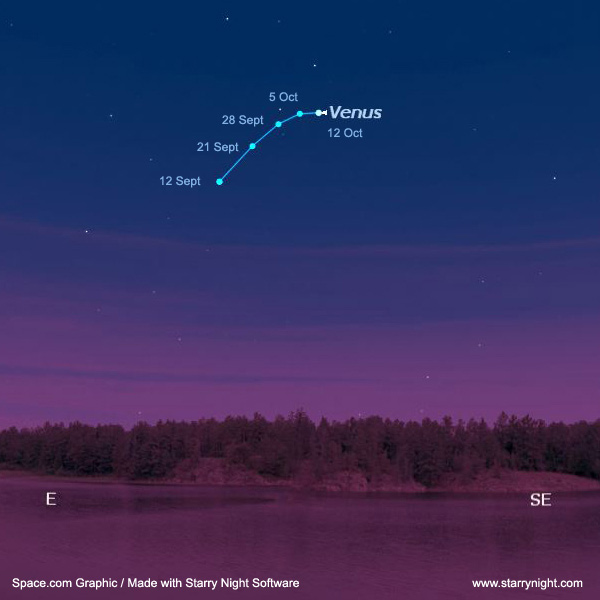Brilliant Venus: Spot the Morning Beacon

The planet Venus has erupted into view in the easternmorning sky during the past couple of weeks.
When September opened, this resplendent Morning Star wasrising just after dawn's first glow at around 5 a.m. local daylight time. Butwith each passing morning, Venus has been rising ever higher and has beengetting a little brighter.
It will attain its greatest brilliance on Sept. 23,appearing at an eye-popping magnitude of -4.6. This is 19 times as bright asthe brighteststar in the sky, Sirius (in Canis Major, the Big Dog), and 10 times asbright as the next-brightest planet, Jupiter. (On this astronomers' scale,smaller numbers represent brighter objects, with negative numbers reserved forthe brightest of all.)
See it during the day
Try looking for Venus through the brilliance of the daytimesky. It can be done if you know exactly where to look. Those who live in ruralareas far from any extraneous light have reported that Venus can cast a faint,yet distinct shadow.
Probably the best method is to simply keep it in view untilafter the sun comes up. At its current extreme brightness, it can often beperceived as a tiny white speck against the blue backdrop of daylight.
And by month's end, it's rising at around 3:30 a.m. and willprecede the sun by some three and a half hours.
Breaking space news, the latest updates on rocket launches, skywatching events and more!
Venus was at inferiorconjunction on Aug. 18, in line between the Earth and the sun. Now it isswinging away from that line, speeding ahead of the Earth in its faster orbit. Soin a telescopeduring September, it displays a large, brilliant, beautiful crescent that waxesin phase all month while shrinking in size.
When September opened,Venus was only 8-percent illuminated, but by month's end, that figure will haveincreased to 33 percent. But because it will have receded 16 million miles fromEarth, the planet will appear more than one-third smaller than it did at thestart of the month.
Magical telescopes
Thoughts of viewing thecrescent of Venus reminds me of an amusing story related by George Lovi (1939-1993),a well-known astronomy lecturer and author who was also a good friend of mine.
One night, while runninga public night at the Brooklyn College Observatory in New York, the telescope was pointed right at Venuswhich was then displaying its delicate crescent shape. Yet one student gazingthrough the telescope eyepiece stubbornly insisted he was not looking at Venus,but at the moon instead. When George commented that the moon wasn't even in thesky, the student replied, "So what? Doesn't a telescope show you things youcan't see without it?"
During the coming weeks, Venus will also be floating ever closerto the bright star, Regulus and the planet Saturn, its evening partners from July.By the end of this month, Venus and Regulus will be separated by about 7 degreesand Venus and Saturn by 10 degrees (your clenched fist held at arm's length measuresroughly ten degrees in width).
Come early in October, this trio – and a lovely crescent moon– will make for some eye-catching configurations in our predawn sky.
- Online Sky Maps and More
- Sky Calendar & Moon Phases
- Astrophotography 101
Joe Rao serves as an instructor and guest lecturer at New York's Hayden Planetarium. He writes about astronomy for The New York Times and other publications,and he is also an on-camera meteorologist for News 12 Westchester, New York.

Joe Rao is Space.com's skywatching columnist, as well as a veteran meteorologist and eclipse chaser who also serves as an instructor and guest lecturer at New York's Hayden Planetarium. He writes about astronomy for Natural History magazine, Sky & Telescope and other publications. Joe is an 8-time Emmy-nominated meteorologist who served the Putnam Valley region of New York for over 21 years. You can find him on Twitter and YouTube tracking lunar and solar eclipses, meteor showers and more. To find out Joe's latest project, visit him on Twitter.
